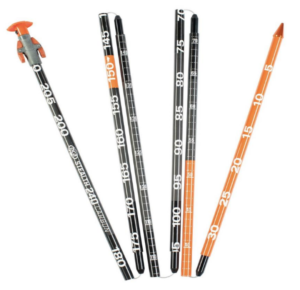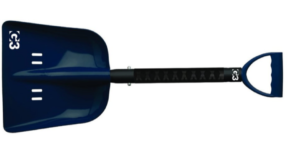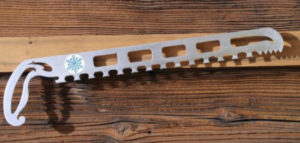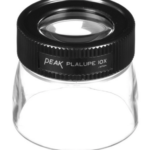Snow-Study Tools: Bruce Jamieson Recommends
We encourage backcountry riders to focus on good craftsmanship when making observations and conducting snowpack tests. Craftsmanship comes from an attention to detail and putting passion and care into the task. It often takes years and continual practice to achieve quality craftsmanship, and it’s going to take even longer if you’re not using the right tools.
Why are the right tools and good craftsmanship important when conducting snowpack observations and tests? We want to reduce any variables and inconsistencies we can when performing tests—because nature already provides significant variability across the terrain. The snowpack’s spatial variability means that we need to repeat observations (same test, similar location) and compare observations (different tests or observations that identify and confirm the same snowpack characteristic) to verify our conclusions. When one observer knows another is conducting and interpreting observations the same way—and they have confidence in that observer’s craftsmanship—it gives us confidence in our conclusions. Or, as Colin Zacharias once stated, “The weather and snowpack vary enough; can’t we all just do the same damn observation the same damn way?”
We leaned on snow and avalanche researcher and consultant Bruce Jamieson for his recommendations on snow-study tools. “I’ve been digging square holes in the snow for over 40 years and have a lot to say about which tools are best.” says Jamieson. “I’m particularly fussy about what I use.”
Bruce started the conversation by highlighting the importance of the shovel and probe. When choosing, he prioritizes first how they will perform when conducting tests and observations, and then rescue. Their ability to efficiently enable quality tests is what keeps him out of avalanches—something he’s been 100% successful at for over 40 years.
Avalanche Probe: Jamieson prefers a 240–270 length versus the 300-plus. “I’m apt to use the shorter length probes more often, because they’re quicker and easier to assemble.” Jamieson currently carries the BCA Stealth Carbon Avalanche Probe, because it’s lightweight, stiff, and has an effective locking mechanism.

Avalanche Shovel: As with many professional avalanche practitioners, Jamieson uses a shovel that has a flat back and blade so he can easily cut clean pit walls and quickly recognize the weak layers. He also prefers a telescoping handle with a D grip. Examples that he would recommend are: G3 Avi Shovel and Voile Telepro. If neither of these fit your personal requirements, select a shove with at least a partially flat back to help you produce those smooth pit walls.

Snow Saw: The Primo El Profesional is the saw Jamieson officially endorses because it is lightweight and affordable. A saw must have a cutting edge over 35 centimeters long (preferably 40 centimeters). It needs to be stiff and sharp so it can easily cut a straight line, and it should preferably be marked in centimeters (or at least have a 30-centimeter mark) for measuring your column tests.

Magnifying Loupe: Jamieson suggests going to a camera store and buying a loupe with a quality lens. He recommends 8x or 10x magnification, which are easier to use in the field. They have longer focal lengths and greater depths of field, which keep more of the crystal in focus. Many believe (mostly men) that increasing the power of magnification will make a snow crystal easier to see, which is not necessarily true. A 20x loupe for example, has virtually no depth of field, meaning the crystal you’re examining will only be in focus at the exact focal point, and it’s difficult to hold an object and a lens steady enough to maintain it. He is currently using a Peak Plalupe 10x. We also recommend the Carson LumiLoupe. Both can be found at B&H Photo, and the Carson loupe is sold at one of my favorite snow-dork sites, Snowmetrics. For a good tutorial on selecting a loupe, click here, and here.

Cord: Critical for efficiently cutting the larger column tests like the propagation saw test (PCT) and extended column test (ECT). Jamieson prefers a 3 millimeter cord with knots every 15 centimeters. You’ll need a length of 3 meters for the PST and ECT, but if you’re doing a Rutschblock test you’ll need 6–7 meters. He does not recommend the cords with metal cleats, as they will destroy your probe when cutting the PST or ECTs. The 3 millimeter cord can be purchased online; you can’t go wrong with Sterling Rope. Buy an extra few meters and stash in your repair kit.
Snow Crystal Card: Jamieson uses a black aluminum card with 2 millimeter and 3 millimeter markings and prefers it to be 15 centimeters long for the deep-tap test. I’m having trouble finding a card with those exact specs, as maybe Jamieson is using a card that’s no longer available. The closest I can find is the BCA Crystal Card.
Ruler: Not much to pontificate on here, other than grab a 2 meter foldable ruler found at Snowmetrics. For those somehow mystified by the mathematical simplicity of the metric system, they do have a version that’s imperial on one side.
Inclinometer: Jamieson, as do many of us now, uses an app on his iPhone for an inclinometer. There’s a few free ones, but it’s hard to pass up Steve’s Badass Avalanche Inclinometer for $3.99. I still use a compass with integrated inclinometer, no batteries required.
For a tutorial and how to use many of the tools mentioned above, please watch Mike Conlan and the Applied Snow and Avalanche Center’s video, Common Snowpack Tests.


